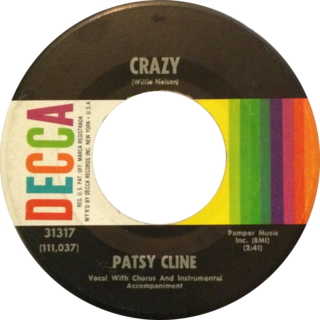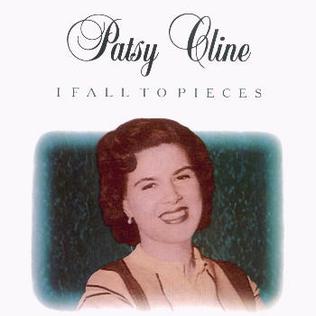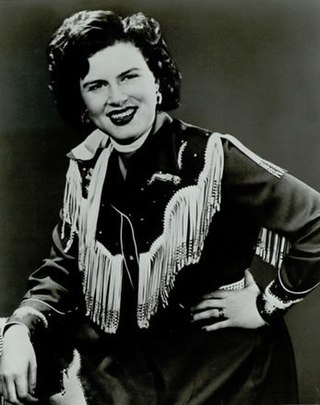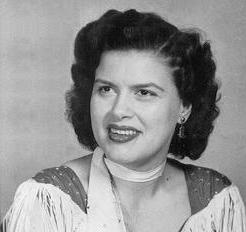
A sound film is a motion picture with synchronized sound, or sound technologically coupled to image, as opposed to a silent film. The first known public exhibition of projected sound films took place in Paris in 1900, but decades passed before sound motion pictures became commercially practical. Reliable synchronization was difficult to achieve with the early sound-on-disc systems, and amplification and recording quality were also inadequate. Innovations in sound-on-film led to the first commercial screening of short motion pictures using the technology, which took place in 1923.

Patsy Cline was an American singer. She is considered one of the most influential vocalists of the 20th century and was one of the first country music artists to cross over into pop music. Cline had several major hits during her eight-year recording career, including two number-one hits on the Billboard Hot Country and Western Sides chart.

Douglas Elton Fairbanks Jr., was an American actor, producer, and decorated naval officer of World War II. He is best-known for starring in such films as The Prisoner of Zenda (1937), Gunga Din (1939), and The Corsican Brothers (1941). The son of Douglas Fairbanks and stepson of Mary Pickford, he was first married, briefly, to actress Joan Crawford.

Cineplex Odeon Corporation was one of North America's largest movie theatre operators and live theatre, with theatres in its home country of Canada and the United States. The Cineplex Odeon brand is still being used by Cineplex Entertainment at some theatres that were once owned by the Cineplex Odeon Corporation, with newer theatres using the Cineplex Cinemas brand. The company was the result of Cineplex Corporation in 1984 purchasing and merging with Canadian Odeon Theatres, which itself was the result of a merger between Canadian Theatres and Odeon Theatres of Canada in 1978.

"Crazy" is a song written by Willie Nelson and popularized by country singer Patsy Cline in 1961. Nelson wrote the song while living in Houston, working for Pappy Daily's label D Records. He was also a radio DJ and performed in clubs. Nelson then moved to Nashville, Tennessee, working as a writer for Pamper Music. Through Hank Cochran, the song reached Patsy Cline. After her original recording and release, Cline's version reached number two on Billboard's Hot Country Singles, also crossing to the pop chart as a top 10 single.

Selznick International Pictures was a Hollywood motion picture studio created by David O. Selznick in 1935, and dissolved in 1943. In its short existence the independent studio produced two films that received the Academy Award for Best Picture—Gone with the Wind (1939) and Rebecca (1940)—and three that were nominated, A Star Is Born (1937), Since You Went Away (1944) and Spellbound (1945).
Metrocolor is the trade name used by Metro-Goldwyn-Mayer (MGM) for films processed at their laboratory. Virtually all of these films were shot on Kodak's Eastmancolor film.

"I Fall to Pieces" is a song written by Hank Cochran and Harlan Howard that was originally recorded by Patsy Cline. Released as a single in 1961 via Decca Records, it topped the country charts, crossed over onto the pop charts and became among Cline's biggest hits. Cline was initially reluctant to record "I Fall to Pieces" and believed its production lacked enough country instrumentation for her liking. Eventually, Cline recorded the song upon the encouragement of her producer.
"Sweet Dreams" or "Sweet Dreams (of You)" is a country ballad, which was written by Don Gibson. Gibson originally recorded the song in 1955; his version hit the top ten of Billboard's country chart, but was eclipsed by the success of a competing version by Faron Young. In 1960, after Gibson had established himself as a country music superstar, he released a new version as a single. This version also charted in the top ten on the country chart and also crossed over to the Billboard Hot 100, where it peaked at number ninety-three. The song has become a country standard, with other notable versions by Patsy Cline and Emmylou Harris.
"She's Got You" is a country song written by Hank Cochran and first recorded and released as a single by Patsy Cline. Musically the song is an upbeat jazz-pop song with country overtones to support it.

"So Wrong" is a song written by Carl Perkins, Danny Dill and Mel Tillis and popularized by country music artist Patsy Cline. The song was released as a single on Decca Records in 1962 by Patsy Cline.

The discography of American music artist Patsy Cline consist of three studio albums, 24 singles, six extended plays, one compilation album, six other charted songs and one album appearance. Cline's discography contains material released during her lifetime. Her first recordings took place under the direction of Four Star Records. Cline's first single, "A Church, a Courtroom, Then Goodbye," was released in July 1955. Four Star issued 17 singles during Cline's four years recording with them. However, only "Walkin' After Midnight" (1957) became a major hit, reaching number 2 on the Billboard country songs chart and number 12 on the Billboard pop music chart.

Home video is recorded media sold or rented for home viewing. The term originates from the VHS and Betamax era, when the predominant medium was videotapes, but has carried over to optical disc formats such as DVD, Blu-ray and streaming media. In a different usage, "home video" refers to amateur video recordings, also known as home movies.

The posthumous discography of American singer Patsy Cline consists of recordings released after March 5, 1963. Since her death, Cline's record label and other labels have released numerous studio albums, compilation albums and singles. Decca Records planned to release Cline's fourth studio album at the time of her death. Instead, a compilation was released in June 1963 titled The Patsy Cline Story. The album reached number 9 on the Billboard country albums list and number 74 on the pop albums chart. Two singles posthumously released in 1963 became top 10 hits on the Billboard country songs chart: "Sweet Dreams " and "Faded Love". Following the release of two posthumous studio albums, Decca issued Patsy Cline's Greatest Hits in 1967. It was the highest-selling female country album for 28 years until Shania Twain surpassed her record in 1995. Greatest Hits was reissued multiple times and eventually was certified diamond in sales in the United States.
Joan Biskupic is an American journalist, author, and lawyer who has covered the United States Supreme Court since 1989.

Ray Steiner Cline was an official at the United States Central Intelligence Agency and is best known for being the chief CIA analyst during the Cuban Missile Crisis.

The Broadcasting Archives at the University of Maryland is home to several collections – the National Public Broadcasting Archives and the Library of American Broadcasting among them – housed together on the campus of the University of Maryland in College Park. Among the other holdings is the unusual Art Gliner Humor Collection, since humor plays such an important part in the history of radio and television programming.

Douglas Evans was an American actor, known for At War with the Army (1950), King of the Rocket Men (1949), and I Saw What You Did (1965).

A Hero for a Night is a 1927 American silent comedy film directed by William James Craft and produced and distributed by Universal Pictures, cashing in on the "Lindy craze", generated by Charles Lindbergh's famous ocean crossing flight. The film stars Glenn Tryon, Patsy Ruth Miller and Burr McIntosh.

Janet E. Steele is a professor of journalism at George Washington University's school of journalism and an author. She published a book with a collection of newspaper articles from Indonesia. She also published a book about Tempo, an Indonesian magazine, during the Soeharto era in Indonesia and wrote a biography of Charles Anderson Dana. It has been described as covering "the complete history of the Sun.
















